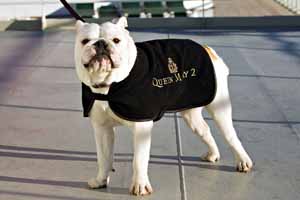Dogs on the High Seas:
Crossing the Ocean With Your Dog(s)
By Jeanne Farewell

Illustration by Jeanne Farewell
Perhaps you’ve heard stories about animals that don’t make it out of the airplane cargo hold alive. Or maybe you have a flat-nosed dog who can’t fly. For whatever reason, if you’re traveling to Europe and want to take your pet, I’d recommend Cunard’s Queen Mary 2.
Feeling a pang for my own pooch on a recent transatlantic crossing, I decided to check out their kennels in case I ever wanted to bring him along. Anthony Samson, the friendly Kennelman for our voyage, welcomed me warmly, and I quickly saw that the seafaring four-footers were in good hands up on Deck 12.
The kennel crew keeps everything clean and shipshape. They make sure the pets have fresh water and let them romp regularly in a gated area on deck. When not promenading and stretching their legs, the dogs are in their crates. The ship has twelve crates for dogs and cats, six large and six small. (Cats have to sign up for two crates: one for the litter box.)
You can cuddle with your dog in the lounge or loaf together in a deck chair in the invigorating sea air. Visiting hours are generous. Basically, you can be with your pet for nearly eight hours a day, and the crossing takes about six days. At the end, your dog earns a Certificate of Completion, and he’ll be glamorously photographed by the roving photographer just like the other passengers onboard.
What will this cost you? For a large lower kennel that accommodates dogs of 26 pounds or more, the price is $700. The smaller upper kennels cost $500, for dogs who are 25 pounds or less. These prices are reasonable when you consider how much you’d pay to board your pet back home, especially for a long trip. But book early to be assured a place, and make sure of the following:
• Dogs going eastbound to the U.K. must be fitted with a microchip, vaccinated against rabies, and blood-tested 6 months before the launch date. They should have an official Veterinary Certificate or PET passport, details of which can be obtained through your veterinarian. Dogs must be treated against ticks or tapeworm between 24 and 48 hours before check-in. (These U.K. guidelines are the same for the European Union countries.)
• Dogs heading westbound back to the U.S. must be issued a health certificate within 30 days of entry into the State of New York, and must have a Rabies Vaccination within 12 months to 14 days prior to entry.
 Worried about seasickness? I asked Anthony about that, and he said he hadn’t seen it in the dogs. They adjust in the first day, and the enormous ocean liner has huge stabilizers that make for smooth sailing. There’s no veterinarian onboard, though, if that is a consideration. Worried about seasickness? I asked Anthony about that, and he said he hadn’t seen it in the dogs. They adjust in the first day, and the enormous ocean liner has huge stabilizers that make for smooth sailing. There’s no veterinarian onboard, though, if that is a consideration.
The Queen Mary 2 makes regular voyages between New York and Southampton, England. Once in Southampton, you can continue to avoid airplanes altogether, and go on to Europe by boat, car, or rail.
If you end up in Paris, though, be sure to take your canine companion to a nice restaurant. It’s not uncommon to see dogs dining with their indulgent owners along the Champs-Élysées, and I visited several English pubs that welcome dogs as well. Some pubs even have their own wooly woofer in residence, so be prepared to be nudged for a nibble. You’ll probably feel right at home.
Bon voyage, you lucky dog!
Credits: Illustration by Jeanne Farewell; photographs courtesy of Cunard Line.
About Jeanne Farewell

Jeanne Farewell is the author of the novels In The Lighthouse and Old Rye,
and a short story collection, Nantucket Snow. Her essays, stories, and book
reviews have been published in literary journals and magazines in the U.S.,
London, and online on the Victorian Web and elsewhere.
Also a pianist, Jeanne has performed in the U.S, China, Europe, and in the
U.K., and has given lecture-recitals about music that is based on art and
literature, sometimes incorporating her own illustrations.
|

